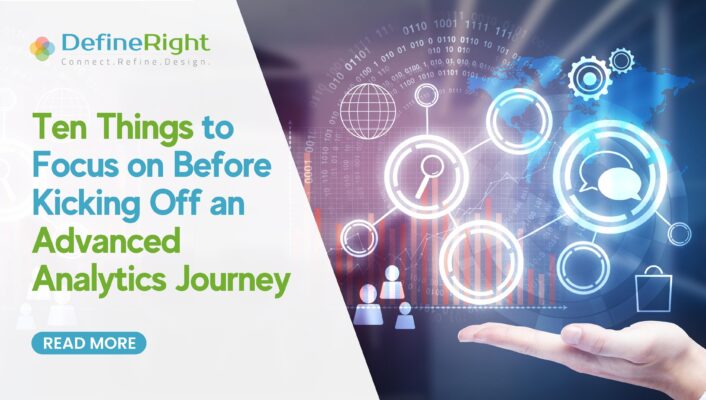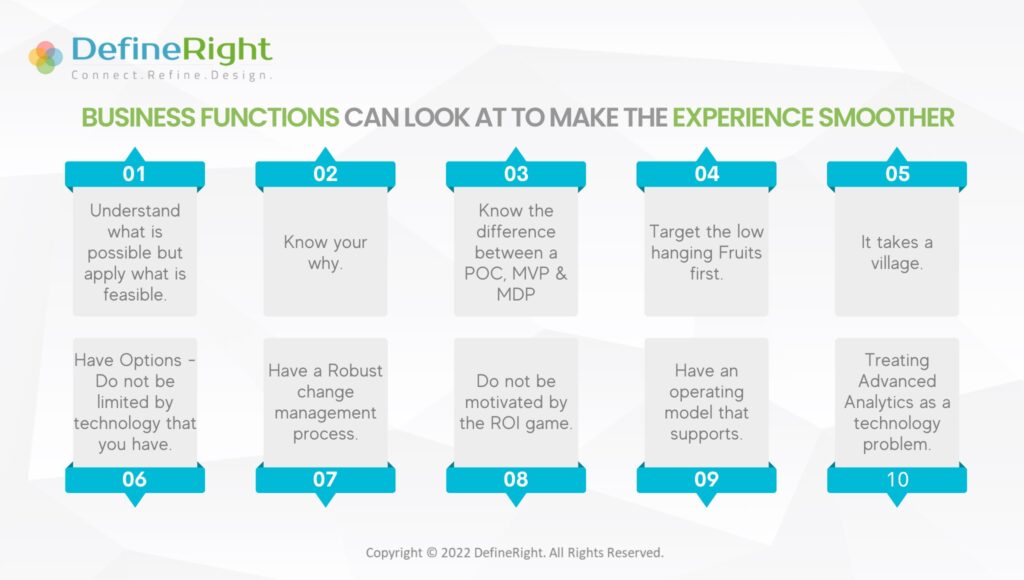
A lot of organizations often hesitate to step into the advanced analytics world because of outcome uncertainty and a clear ROI. It is something everyone wants to have but everyone is sitting on the fence and do not want to take the plunge unless they know that it will work. Even now when access to tools and technologies has been globally democratized, most enterprises are fence sitters when it comes to Advanced Analytics and in line with historical trends, wait for the early adopters to experiment first.
Unfortunately looking at the implementation experience of others and deciding based on that if a specific advanced analytics project will work for an organization is not the right approach. This is because problems may look similar on the outside but it never is unidimensional. The data landscape, people skill, technological and process maturity is always at different levels in different organizations. And this is when we are not considering the most important constraint of all – Budget.
However, there are things that we can do in order to reduce the uncertainty and challenges of an advanced analytics journey. Here are a few aspects that I have borrowed from my experiential learning so far and that business functions can look at to make the experience smoother:

1. Understand What Is Possible but Apply What Is Feasible
Often organizations benchmark against each other and aim to bring similar advanced analytics program within their organization. While benchmarking can be a good practice as it shows where the industry is going, organizations should keep in mind that problems that may look similar on the outside are often not. The underlying dimensions of a problem is specific to the data, people, systems and processes of that specific organization. So though one can take inspiration from outside, the decision to whether commit to that program must be evaluated for feasibility keeping the organization’s specific landscape in mind.
2. Know Your Why
Breaking down and identifying the Why is an important step. Be very clear on why you want to take your business function towards the advanced analytics journey. And the answer should not be because everyone is using it. However, if you think it is necessary to solve some of the critical challenges your function and organization is facing then that could be one of your why. This is the stage when one has to get into specifics and have a thorough understanding of the problem being solved.
3. Know the Difference Between a Poc, MVP and MDP
The above terms are frequently used interchangeably, it is important to keep in mind that Proof of Concept (PoC), MVP (Minimum Viable Product) and MDP (Minimum Desirable Product) are very different in their scope and application. A PoC is something which is done in the pre-product stage and requires minimal to medium investment and is done more from a technical feasibility angle to demonstrate the business concept. When we build an MVP, we enter the product stage which means that it has all the core features and functionalities to see how the users will receive it but it is being built still with only essential features and around constraints. After the MVP shows potential that is when the program enters into full fledged product development phase which is where the scale and product operationalization happens and we enter the MDP phase. This is where all user feedback and requirements are incorporated into the product and we get a wider rollout. Having a governance or stage-gate process to ensure that you have rules that allow the product to move from one stage to another will help in ultimately operationalizing the solution, something which still is the biggest challenge in the advanced analytics space.
4. Target the Low Hanging Fruits First
If you are very new in the advanced analytics journey it is important to target the low hanging fruits. Targeting the low hanging fruits and optimizing them allows you to demonstrate the importance of advanced analytics and allows you to slowly shift the culture of the organizations. You will then see more use cases being highlighted by your teams vs all the use cases coming from the top level of the organization.
5. It Takes a Village
Running an advanced analytics program is effort and resource intensive and needs buy-in from all levels. You cannot have a technology team or data scientist working on it in silo. You have to bring together your functional and data and process experts sometimes from different functions to provide timely guidance. Very often this does not happen because breaking organization silos involves a cultural change. Further getting time commitments from functional or business experts who have their own set of priorities is always hard. That is why the person running the program should have the stakeholder management skills to bring the right people together for what they need and also optimize the time of all the stakeholders by knowing who needs to be approached for what and when.
6. Have Options – Do Not Be Limited by Technology That You Have
Business functions often work with tools that is approved by their enterprise or function. Using Approved tools is important because you know that the governance process for those tools is established. However sometimes there are certain tools etc. that you will need for optimum work and you should have a process in place on how to deal with those exception. These exceptions can specially come useful while doing a PoC or MVP to establish their efficacy and features. Most organizations now have a bunch of technologies that they work with and so this should not be an issue however for organizations with a limited tech ecosystem should keep this in mind.
7. Have a Robust Change Management Process
Change Management is extremely critical and often overlooked. Advanced Analytics or for that matter any other Business Project is about People and when we have a people element, there is always resistance to change. Advanced analytics would almost always lead to new ways of working. It is imperative that there is a change management plan integrated with your project management plan for the advanced analytics program that you are running which may require upskilling, training programs, constant reiteration etc for all team members.
8. Do Not be Motivated by the ROI Game
This is something that I learnt in my entrepreneurial incubation program. We should not always play the return-on-investment game. Just like for a new venture to take decisions based on ROI is not easy because of limited benchmarked metrics, so it is for organizations that are looking to prioritize use cases based on ROI. It is hard to accurately calculate the ROI for any advanced analytics projects. Instead you should have smaller milestones and look at achieving that before going the next step. Rather than looking at Return on Investment maybe look at if is the solution going to make one of your critical business processes easier to do and make it error free.
9. Have an Operating Model That Supports
Most organizations and business functions start their planning cycle with great enthusiasm about advanced analytics. However, as time passes and other strategic initiatives or business as usual takes over, the enthusiasm fades. Business was running even before this advanced analytics program so the thought is that always to put it aside and get back to it when the time permits. Another truth is that running an advanced analytics program is not all about doing the cool and cutting-edge technology work. Seventy percent of the time is about rolling up your sleeves, getting your hands dirty and doing the grunt work. This work is absolutely critical as well and the quality of this has to be top notch because this is the foundation on which your entire program will start. This is where vendors that have the understanding of the domain and can bring in different skill sets and scale up and down as needed could be very useful.
10. Treating Advanced Analytics as a Technology Problem
The last but not the least Implementing an Advanced analytics program is not merely a technology problem and treating it as such will not extract all the potential from the solution. At the end of the day even the most advanced technologies are used to solve a Business Problem and that’s is where crux of solutioning lies. Make sure you spend enough time in discovering the problem and exploring the various underlying dimensions of people, data, systems and process before starting to develop the solution and operationalizing it. Otherwise, what we get in the end is a solution looking for a problem to solve and that sets even future initiatives back by miles.
With all the above aspects, ensuring that your advanced analytics team and programs have adequate business representation is extremely critical.
At DefineRight with our acquired domain experience and discovery focussed delivery approach help organizations start their advanced analytics journey. Our discovery focussed delivery approach allows us to ask the right questions and speed up the discovery phase, our size gives business functions access to a flexible and agile operating model and our technical expertise ensures that the solutions built can be scaled and well-integrated with business processes and operations.
